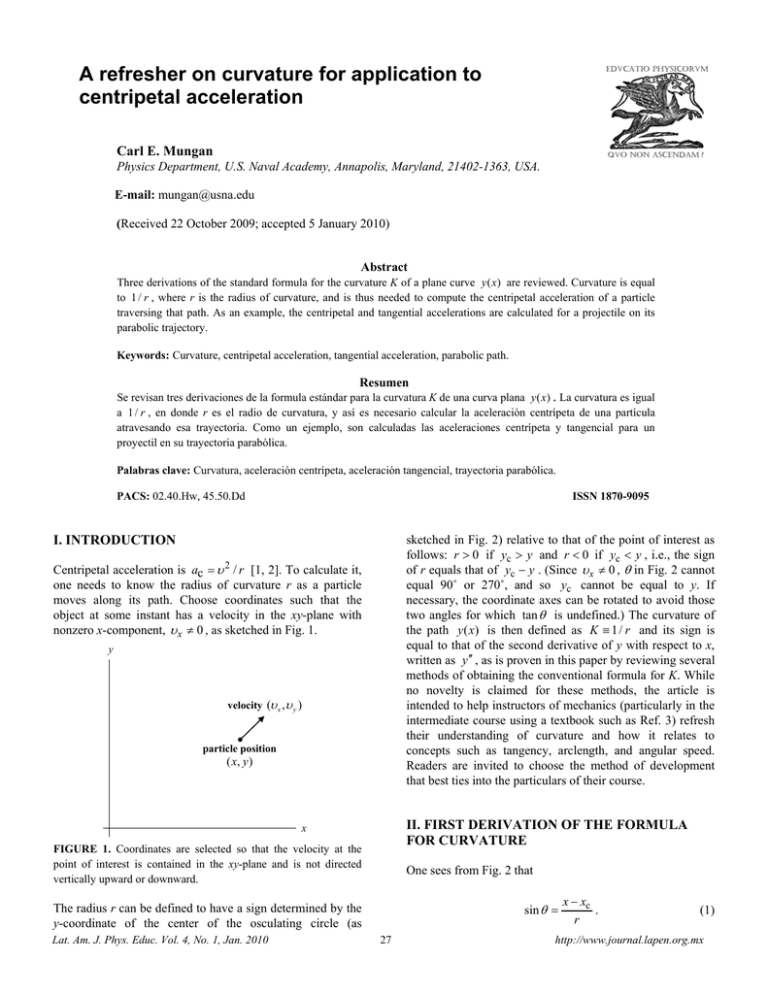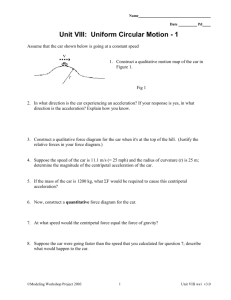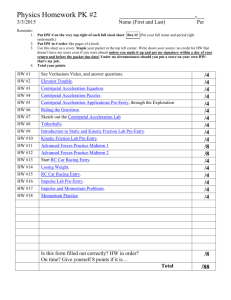A refresher on curvature for application to centripetal acceleration Carl E. Mungan
advertisement

A refresher on curvature for application to centripetal acceleration Carl E. Mungan Physics Department, U.S. Naval Academy, Annapolis, Maryland, 21402-1363, USA. E-mail: mungan@usna.edu (Received 22 October 2009; accepted 5 January 2010) Abstract Three derivations of the standard formula for the curvature K of a plane curve y ( x) are reviewed. Curvature is equal to 1 / r , where r is the radius of curvature, and is thus needed to compute the centripetal acceleration of a particle traversing that path. As an example, the centripetal and tangential accelerations are calculated for a projectile on its parabolic trajectory. Keywords: Curvature, centripetal acceleration, tangential acceleration, parabolic path. Resumen Se revisan tres derivaciones de la formula estándar para la curvatura K de una curva plana y ( x) . La curvatura es igual a 1 / r , en donde r es el radio de curvatura, y así es necesario calcular la aceleración centrípeta de una partícula atravesando esa trayectoria. Como un ejemplo, son calculadas las aceleraciones centrípeta y tangencial para un proyectil en su trayectoria parabólica. Palabras clave: Curvatura, aceleración centrípeta, aceleración tangencial, trayectoria parabólica. PACS: 02.40.Hw, 45.50.Dd ISSN 1870-9095 I. INTRODUCTION sketched in Fig. 2) relative to that of the point of interest as follows: r > 0 if yc > y and r < 0 if yc < y , i.e., the sign of r equals that of yc − y . (Since υ x ≠ 0 , θ in Fig. 2 cannot equal 90˚ or 270˚, and so yc cannot be equal to y. If necessary, the coordinate axes can be rotated to avoid those two angles for which tan θ is undefined.) The curvature of the path y ( x) is then defined as K ≡ 1/ r and its sign is equal to that of the second derivative of y with respect to x, written as y ′′ , as is proven in this paper by reviewing several methods of obtaining the conventional formula for K. While no novelty is claimed for these methods, the article is intended to help instructors of mechanics (particularly in the intermediate course using a textbook such as Ref. 3) refresh their understanding of curvature and how it relates to concepts such as tangency, arclength, and angular speed. Readers are invited to choose the method of development that best ties into the particulars of their course. Centripetal acceleration is ac = υ 2 / r [1, 2]. To calculate it, one needs to know the radius of curvature r as a particle moves along its path. Choose coordinates such that the object at some instant has a velocity in the xy-plane with nonzero x-component, υ x ≠ 0 , as sketched in Fig. 1. y velocity (υ x ,υ y ) particle position ( x, y ) II. FIRST DERIVATION OF THE FORMULA FOR CURVATURE x FIGURE 1. Coordinates are selected so that the velocity at the point of interest is contained in the xy-plane and is not directed vertically upward or downward. One sees from Fig. 2 that sin θ = The radius r can be defined to have a sign determined by the y-coordinate of the center of the osculating circle (as Lat. Am. J. Phys. Educ. Vol. 4, No. 1, Jan. 2010 27 x − xc . r (1) http://www.journal.lapen.org.mx Carl E. Mungan III. SECOND DERIVATION Differentiating both sides with respect to x gives the curvature as1 1 θ ′ cos θ = = K . r The differential arclength of the curve y ( x) at the tangent point is found from Fig. 3 to be (2) ds = r dθ osculating circle centered at , (7a) dθ , ds (7b) which rearranges as ( xc , yc ) K= x xc r often taken in math courses to be the definition of “curvature.” Next, according to the Pythagoras theorem, θ θ ds = dx 2 + dy 2 = 1 + y ′2 dx . tangent point ( x, y ) (8) Substituting Eq. (8) into (7b) gives y ( x) K= θ′ 1 + y ′2 . (9) But Eq. (3) implies FIGURE 2. Geometry of the circle of curvature (or “osculating circle”) at the same point ( x, y ) as in Fig. 1. A tangent to the curve at that point makes angle θ with respect to the x-axis. θ = tan −1 y ′ ⇒ θ ′ = However, the slope of the curve y ( x) at the tangent point can be written in two different ways, y ′ = tan θ , y ′′ 1 + y ′2 , (10) which when substituted into Eq. (9) leads to Eq. (6) again. (3) and thus cos θ = 1 1 1 = = . 2 sec θ 1 + tan θ 1 + y ′2 (4) θ On the other hand, differentiating Eq. (3) again with respect to x leads to y ′′ = θ ′ sec2 θ ⇒ θ ′ = y ′′ cos 2 θ . dθ r ds (5) Finally, substitute both Eqs. (4) and (5) into Eq. (2) to get K= y ′′ ( 1 + y ′2 ) 3/2 , (6) FIGURE 3. An infinitesimal element of arclength ds at the point ( x, y ) in Figs. 1 and 2 is common both to the osculating circle and to the particle’s path. which is the desired formula. 1 Throughout this paper, primes denote x-derivatives. Lat. Am. J. Phys. Educ. Vol. 4, No. 1, Jan. 2010 28 http://www.journal.lapen.org.mx A refresher on curvature for application to centripetal acceleration IV. THIRD DERIVATION and finally note that the quantity in parentheses is equal to 1, in accord with Eq. (7a) divided through by dt. This completes the aside. Returning to Eq. (12), G The differential displacement dr has magnitude ds (indicated in Fig. 3) and has direction defining the unit tangent vector tˆ to the curve y ( x) at that point, so that G dr tˆ = . ds (11) −rˆ = dθ , K = (12) G 1 d 2r = r ds 2 , (18) which gives another possible way to define curvature. It is easiest to compute this second derivative using the chain rule. Equation (17) becomes which can alternatively be called the unit normal vector n̂ to the curve. As an aside, note that Eq. (12) can be proven in at least two ways. One method is to write rˆ = cos θ iˆ + sin θ jˆ , (17) using Eq. (7a) to obtain the second equality, and Eq. (11) to get the third one. Taking the magnitudes of both sides of Eq. (17) leads to Using the plane polar coordinates shown in Fig. 3, tˆ can be identified with the unit azimuthal vector θˆ . It then follows that the unit inward radial vector is dθˆ G dtˆ dtˆ d 2r , =r =r dθ ds ds 2 nˆ = nˆ = r (13a) G dx d ⎛ dx dr ⎞ ⎜ ⎟. ds dx ⎝ ds dx ⎠ (19) Noting from Eq. (8) that and θˆ = − sin θ iˆ + cos θ jˆ , in terms of the rectangular unit vectors iˆ and jˆ (relative to an origin at the center of the osculating circle with the x-axis pointing downward and the y-axis pointing rightward). Then the θ-derivative of Eq. (13b) gives the negative of Eq. (13a) as desired. A second method is to divide the numerator and denominator of Eq. (11) by the time interval dt and rearrange G to get the velocity υ = υ tˆ , which as expected is tangential. Now take its time derivative to obtain the acceleration, dθˆ G dυ ˆ a= t +υ . dt dt dθˆ nˆ = υ . r dt Lat. Am. J. Phys. Educ. Vol. 4, No. 1, Jan. 2010 G dr d = ( x, y ) = (1, y ′) , dx dx (20b) then Eq. (19) becomes nˆ = (14) d ⎡⎢ (1, y ′) 1 + y ′2 dx ⎢⎣ 1 + y ′2 r ⎤ ⎥, ⎥ ⎦ (21) where the quantity in square brackets is just tˆ . Performing the remaining x-derivative gives 1 nˆ = r (15) Next divide both sides of this equation by both the linear speed υ and the angular speed ω ≡ dθ / dt to get dθˆ ⎛ υ ⎞ , ⎜ ⎟ nˆ = dθ ⎝ rω ⎠ (20a) and that The first term on the right-hand side is the tangential acceleration at tˆ . Therefore the second term must be the centripetal acceleration ac nˆ and thus υ2 dx 1 , = ds 1 + y ′2 (13b) y ′′ ( 1 + y ′2 ) 3/2 ⎡ (− y ′,1) ⎢ ⎢ 1 + y ′2 ⎣ ⎤ ⎥. ⎥ ⎦ (22) One can identify the quantity in this square brackets with n̂ based on three observations: it has unit magnitude, it is perpendicular to tˆ identified in Eq. (21), and it has a negative x-component and positive y-component when the slope y ′ is positive at the point of interest, as it is in Figs. 1 to 3. Then what is left of Eq. (22) after n̂ is factored out of both sides is Eq. (6) once again. (16) 29 http://www.journal.lapen.org.mx Carl E. Mungan V. EXAMPLE PROBLEM at = A ball is thrown horizontally off the edge of a cliff with initial speed υ0 . Find its tangential and centripetal accelerations when it is a horizontal distance x from the cliff, neglecting air resistance. Let the origin of time and of the axes be at the launch point, with x in the forward direction and y vertically downward, as sketched in Fig. 4. By energy conservation, at point ( x, y ) the ball has speed υ= υ02 + 2gy . cos θ = υ02 υ04 + g 2 x 2 sin θ = 1 − cos 2 θ = cliff ( x, y ) ac , (27a) and thus x θ (26b) by again using Eqs. (23) and (24). As expected intuitively ac → g and at → 0 as x → 0 , while in the opposite limit, ac → 0 and at → g as x → ∞ . This completes the problem. As a further check on these two expressions, note that Eqs. (4) and (24) imply (23) υ0 dυ g2x = , dt υ04 + g 2 x 2 θ gx υ04 + g 2 x 2 . (27b) One can then use the geometry of the orthogonal acceleration components sketched in Fig. 4 to correctly compute at ax = at cos θ − ac sin θ = 0 , (28a) a y = at sin θ + ac cos θ = g . (28b) and y Similar calculations can be used to find the acceleration components of a bead sliding on a wire [3], of a car executing a turn on a horizontal road [4], or of a rolling cart descending a hill [5]. As a final application of Eq. (6), readers are invited to verify that at perihelion (or aphelion), the radius of curvature of an elliptical orbit equals the semilatus rectum. Setting the centripetal acceleration equal to the gravitational field at that point then quickly leads to an expression for the perihelion speed and hence for the conserved energy and angular momentum of the planet [6]. FIGURE 4. Centripetal and tangential acceleration components at position ( x, y ) along the path of the ball. The path is parabolic, described by x = υ0 t y = gt 1 2 ⇒ 2 g y= 2υ02 x2 , (24) and so Eq. (6) becomes 1 = r g υ04 ( υ04 + g 2 x 2 VI. CONCLUSIONS ) 3/2 . (25) The first derivation of the curvature K used trignometry and the geometrical slope of the curve y ( x) . The second derivation also used the slope but combined it with the arclength of the curve. The third derivation, although the longest, has the merit of being explicitly vector-based and directly connects to plane polar coordinates as typically introduced in intermediate mechanics courses [3]. Other formulas for K can also be developed, such as one2 that can be used when the curve is parameterized by t (which might Combining this result with Eqs. (23) and (24) gives ac = υ2 r = g υ02 υ04 + g 2 x 2 . (26a) Furthermore Application of the chain rule in the form d / dx = x −1 d / dt transforms Eq. (6) into K = ( x y − y x ) / ( x 2 + y 2 )3/ 2 where overdots denote 2 t-derivatives. Lat. Am. J. Phys. Educ. Vol. 4, No. 1, Jan. 2010 30 http://www.journal.lapen.org.mx A refresher on curvature for application to centripetal acceleration G denote time) as r = x (t ) iˆ + y (t ) jˆ , but are seldom as useful in physics as Eq. (6). A rich variety of illustrative calculations of centripetal and tangential accelerations, beyond the parabolic case presented here, can be found in Refs. 2–6. Many of these examples are worth taking some class time to treat in a mechanics course. REFERENCES [1] Jones, H. W. and Wallingford, J. S., A simple derivation of the centripetal force, Am. J. Phys. 37, 751 (1969). [2] Singh, C., Centripetal acceleration: Often forgotten or misinterpreted, Phys. Educ. 44, 464–467 (2009). [3] Fowles, G. R. and Cassiday, G. L., Analytical Mechanics, 6th ed. (Thomson Brooks Cole, Belmont CA, 1999), Chap. 1. [4] Mungan, C. E., Accelerating around an unbanked curve, Phys. Teach. 44, 99–100 (2006). [5] Pendrill, A., Rollercoaster loop shapes, Phys. Educ. 40, 517–521 (2005). [6] <http://usna.edu/Users/physics/mungan/Scholarship/ EllipticalOrbits.pdf> Visited January 25, 2010. ACKNOWLEDGMENT Larry Tankersley has written a white paper on centripetal acceleration which reviews many similar ideas to those presented here. Lat. Am. J. Phys. Educ. Vol. 4, No. 1, Jan. 2010 31 http://www.journal.lapen.org.mx



